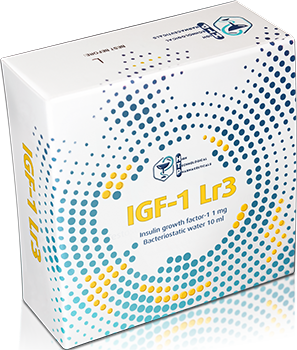IGF-1 Lr3

Description:
IGF-1LR3 long arginine 3-IGF-1, abbreviated as IGF-1 LR3 or LR3-IGF-1, is a synthetic protein and a human insulin-like growth factor-1 (IGF-1) analog. It differs from the natural IGF-1 by having arginine instead of glutamic acid at the third position in the amino acid sequence and also has an additional 13 amino acids at its N-terminus and thus becomes a total of 83 amino acids (with respect to IGF-1 who has 70). The consequences of these modifications are that IGF-1 LR3 retains the pharmacological activity of IGF-1 as an IGF-1 receptor agonist, has a very low affinity for insulin-like growth factor binding proteins (IGFBPs) and metabolic stability. As a result, it is approximately three times stronger than IGF-1 and has a significantly longer half-life of about 20-30 hours (with respect to the half-life of IGF-1-12-15 hours).
Dose and administration:
IGF-1LR3 is a fine white powder in a vial to be mixed with bacteriostatic water. The powder should be stored in dry and cool places without direct sunlight. The solution should be used with subcutaneous injection into the body fat using a very small insulin needle. Once combined in the solution, the serum should be stored in a refrigerator (between 2 and 8 ° C / 36 ° F and 46 ° F) because the amino acid chain is likely to disintegrate and this may affect its effectiveness. The usual doses of IGF-1LR3 may vary dramatically. It is not unusual to administer 50 micrograms or more per day. However, this may be a little more and even more than necessary to achieve good results. In most cases, 15 micrograms per day with a slight periodic increase if necessary is absolutely sufficient. The overall use of IGF-1LR3 as all IGF hormones is usually 3-4 weeks.
Overdosage:
If overdose of IGF-1 Lr3 is suspected, contact your Doctor immediately.